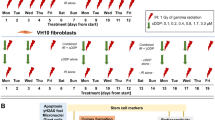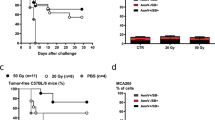Abstract
Purpose
Previous work from this laboratory has demonstrated that the vitamin D3 analogs EB 1089 and ILX 23-7553 enhance the response of breast tumor cells to ionizing radiation and promote radiation-induced apoptotic cell death. The current studies were designed to more closely simulate clinical radiotherapy in the treatment of breast cancer by examining the utility of ILX 23-7553 as an adjunct to fractionated ionizing radiation. The potential toxicity to normal tissue of the combination of ILX 23-7553 and fractionated radiation was assessed in a model of BJ human fibroblasts in culture.
Methods
MCF-7 cells and human fibroblasts were treated with fractionated radiation alone (5×2 Gy over 3 days), ILX 23-7553 alone (50 nM) or ILX 23-7553 followed by 5×2 Gy. Viable cell numbers were determined by trypan blue exclusion and apoptosis by the TUNEL assay. A statistical model of additivity was utilized to assess the nature of the interaction between ILX 23-7553 and fractionated radiation.
Results
Radiation and ILX 23-7553 each alone reduced viable cell numbers by 72±3.1% and 62±4.8%, respectively. Pretreatment with ILX 23-7553 followed by 5×2 Gy reduced viable cell numbers by 93.2±0.7%. The interaction between ILX 23-7553 and fractionated radiation appeared to be additive despite the fact that the combination of ILX 23-7553 and fractionated radiation also promoted a twofold increase in apoptotic cell death. ILX 23-7553 failed to enhance the response to radiation or to promote apoptosis in BJ human foreskin fibroblasts.
Conclusions
ILX 23-7553 enhanced the antiproliferative and apoptotic effects of fractionated ionizing radiation in MCF-7 breast cancer cells. These effects appeared to be selective in that similar responses were not observed in a model of normal human fibroblasts. Vitamin D3 analogs such as ILX 23-7553 may prove to have utility in combination with conventional radiotherapy of breast cancer as well as other malignancies which are sensitive to vitamin D3.




Similar content being viewed by others
References
American Cancer Society (2001) Cancer facts and figures 2001. Atlanta, GA
Greenlee RT, Hill-Harmon MB, Murray T, Thun M (2001) Cancer statistics, 2001. CA Cancer J Clin 51:15
Pisani P, Parkin DM, Bray F, Ferlay J (1999) Estimates of the worldwide mortality from 25 cancers in 1990. Int J Cancer 83:18
Colston KW, Mackay AG, James SY, Binderup L, Chander S, Coombes RC (1992) EB1089: a new vitamin D analogue that inhibits the growth of breast cancer cells in vivo and in vitro. Biochem Pharmacol 44:2273
Mathiasen IS, Colston KW, Binderup L (1993) EB 1089 a novel vitamin D analogue has strong antiproliferative and differentiation inducing effects on cancer cells. J Steroid Biochem Mol Biol 46:365
Wu G, Fan RS, Li W, Ko TC, Brattain MG (1997) Modulation of cell cycle control by vitamin D3 and its analogue EB1089 in human breast cancer cells. Oncogene 25:1555
Simboli-Campbell M, Narvaez CJ, van Weelden K, Tenniswood M, Welsh J (1997) Comparative effects of 1,25(OH)2D3 and EB1089 on cell cycle kinetics and apoptosis in MCF-7 breast cancer cells. Breast Cancer Res Treat 42:31
Narvaez CJ, Welsh J (2001) Role of mitochondria and caspases in vitamin D-mediated apoptosis of MCF-7 breast cancer cells. J Biol Chem 276:9101
Gewirtz DA, Gupta MS, Sundaram S (2002) Vitamin D3 and vitamin D3 analogues as an adjunct to cancer chemotherapy and radiotherapy. Curr Med Chem Anticancer Agents 2:683
Sundaram S, Gewirtz DA (1999) The vitamin D3 analog EB 1089 enhances the response of human breast tumor cells to radiation. Radiat Res 152:47
Sundaram S, Chaudhry M, Reardon D, Gupta M, Gewirtz DA (2000) EB 1089 enhances the antiproliferative and apoptotic effects of adriamycin in MCF-7 breast tumor cells. Breast Cancer Res Treat 63:1
Chaudhry M, Sundaram S, Gennings C, Carter H, Gewirtz DA (2001) The vitamin D analog ILX-23-7553 enhances the response to adriamycin and irradiation in MCF-7 breast tumor cells. Cancer Chemother Pharmacol 47:429
Gewirtz DA (2000) Growth arrest and cell death in the breast tumor cell in response to ionizing radiation and chemotherapeutic agents which induce DNA damage. Breast Cancer Res Treat 62:223
Gavrieli Y, Sherman Y, Ben-Sasson SA (1992) Identification of programmed cell death in situ via specific labeling of nuclear DNA fragmentation. J Cell Biol 19:493
Gennings C, Schwartz P, Carter WH Jr, Simmons JE (1997) Detection of departures from additivity in mixtures of many chemicals with a threshold model. J Agric Biol Environ Stat 2:198
Bae DS, Gennings C, Carter WH Jr, Yang RS, Campain JA (2001) Statistical analysis of interactive cytotoxicity in human epidermal keratinocytes following exposure to a mixture of four metals. Toxicol Sci 63:132
Watson NC, Di YM, Orr MS, Fornari FA Jr, Randolph JK, Magnet JK, Jain PT, Gewirtz DA (1997) Influence of ionizing radiation on proliferation c-myc expression and the induction of apoptotic cell death in two breast tumor cell lines differing in p53 status. Int J Radiat Biol 72:547
Schmidt-Ullrich RK, Contessa JN, Dent P, Mikkelsen RB, Valerie K, Reardon DB, Bowers G, Lin PS (1999) Molecular mechanisms of radiation-induced accelerated repopulation. Radiat Oncol Investig 7:321
Jacques PF, Felson DT, Tucker KL, Mahnken B, Wilson PW, Rosenberg IH, Rush D (1997) Plasma 25-hydroxyvitamin D and its determinants in an elderly population sample. Am J Clin Nutr 66:929
Harris SS, Dawson-Hughes B (1998) Seasonal changes in plasma 25-hydroxyvitamin D concentrations of young American black and white women. Am J Clin Nutr 67:1232
Kristinsson JO, Valdimarsson O, Sigurdsson G, Franzson L, Olafsson I, Steingrimsdottir L (1998) Serum 25-hydroxyvitamin D levels and bone mineral density in 16–20 year old girls: lack of association. J Intern Med 243:381
Janicke RU, Ng P, Sprengart ML, Porter AG (1998) Caspase-3 is required for alpha-fodrin cleavage but dispensable for cleavage of other death substrates in apoptosis. J Biol Chem 273:15540
Szumiel I (1994) Ionizing radiation-induced cell death. Int J Radiat Biol 66:329
Hendry JH, West CM (1997) Apoptosis and mitotic cell death: their relative contributions to normal-tissue and tumour radiation response. Int J Radiat Biol 71:709
Chang WP, Little JB (1992) Delayed reproductive death in X-irradiated Chinese hamster ovary cells. Int J Radiat Biol 60:483
Manggau M, Kim DS, Ruwisch L, Vogler R, Korting HC, Schafer-Kortin GM, Kleuser B (2001) 1Alpha, 25-dihydroxyvitamin D3 protects human keratinocytes from apoptosis by the formation of sphingosine-1-phosphate. J Invest Dermatol 117:1241
Sundaram S, Sea A, Feldman S, Strawbridge R, Hoopes PJ, Demidenko E, Binderup L, Gewirtz DA (2003) The combination of the a potent vitamin D3 analog, EB 1089 with ionizing radiation reduces tumor growth and induces apoptosis of MCF-7 breast tumor xenografts in nude mice. Clin Cancer Res (in press)
Acknowledgements
This work was supported by U.S. Army DAMD 17-96-1-6167, American Institute for Cancer Research Award 99A091 and a grant from ILEX Products Inc. Mona Gupta was supported by American Institute for Cancer Research Award 2A068.
Author information
Authors and Affiliations
Corresponding author
Rights and permissions
About this article
Cite this article
Polar, M.K., Gennings, C., Park, M. et al. Effect of the vitamin D3 analog ILX 23-7553 on apoptosis and sensitivity to fractionated radiation in breast tumor cells and normal human fibroblasts. Cancer Chemother Pharmacol 51, 415–421 (2003). https://doi.org/10.1007/s00280-003-0606-z
Received:
Accepted:
Published:
Issue Date:
DOI: https://doi.org/10.1007/s00280-003-0606-z




